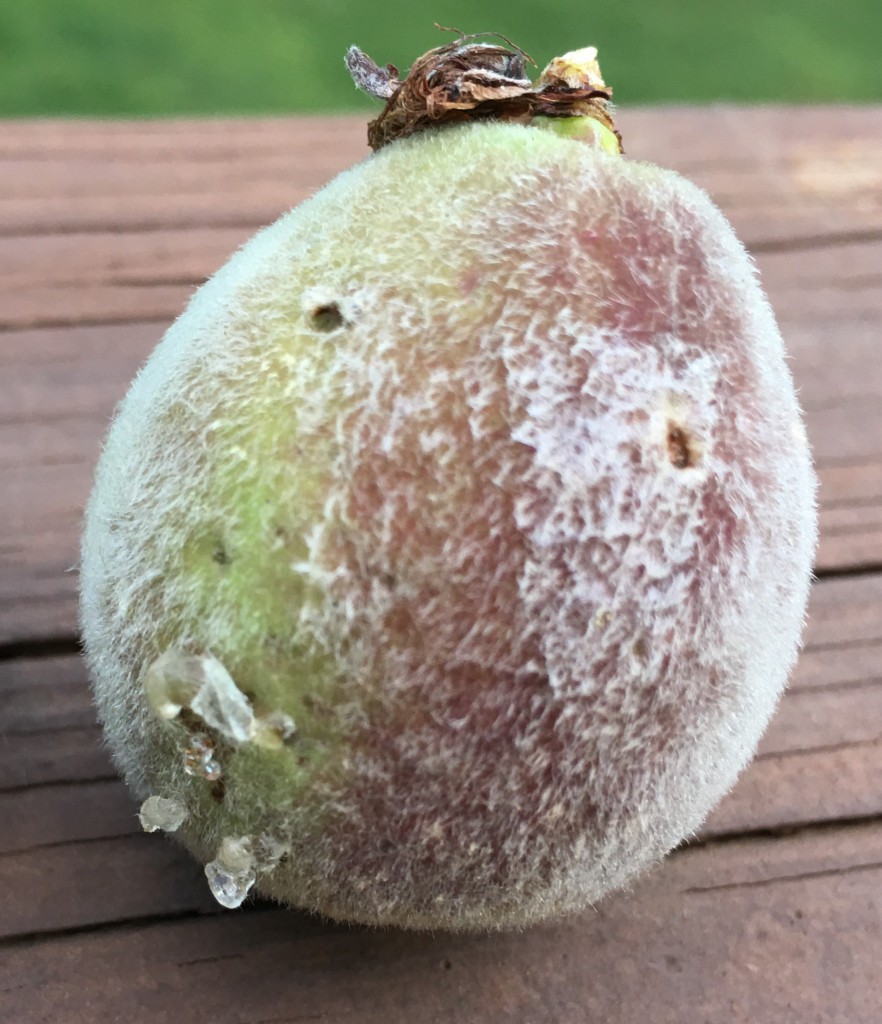Not to get sappy about peaches, but we came very close to losing the entire crop this year. We reached a low temperature of 32F degrees last week. A few more degrees colder could have been devastating to many of our fruit trees in north Georgia. Even late blooming varieties wouldn’t have made much of a difference with the early spring weather we’ve been enjoying this year.
I noticed blackberries started blooming this week. If you’re familiar with Georgia weather, this “blackberry winter” should be no surprise to anyone. It’s quite common to get a late spring frost in mid-April. This reinforces why it’s important to consider both soil temperatures and frost potential when deciding to plant your summer vegetables.
Speaking of sappy peaches, our office has received several calls this week about sap bleeding out of peach tree stems and fruit. The oozing sap on stems and fruit are actually caused by two different issues. The exuding of sap or gum from the stems of stone fruit trees (peaches, plums, cherry) is so common it has been given the name gummosis. The name gummosis does not define a specific cause. Peachtree borer (moth) injury and simple mechanical injury can result in gummosis. If the gum is exuding high up on the trunk or branches rather than from near the root crown, the bleeding is not likely caused by borer larvae. Borers will also leave sawdust within the gum.
There are several infectious diseases (fungal or bacterial cankers) that can result in gummosis. In most cases where a canker disease is concerned, the infected tree has been under some type of environmental stress. More than likely, the sap you are seeing now is the result of drought stress from last summer and fall. The presence of gummosis does not mean the tree will die and there are no treatments for these disorders. Minimizing tree stress is the key to prevention.

The sap coming out of fruit is a symptom of damage from sap-feeding insects such as stink bugs and tarnished plant bugs. These insects use their needle-like mouth parts to feed on the developing fruit, which kills the tissue at the feeding site, resulting in oozing sap. This feeding damage can also cause dimples to form on the fruit known as “catfacing” injury. Minor damage is mostly cosmetic and the fruit is still edible if it makes it to the ripening stage. Severe damage creates large crevices and tough cork-like flesh in the fruit, which is not palatable.
Insecticide sprays can protect fruit that are not yet damaged. Home orchard sprays that contain permethrin, gamma cyhalothrin or other pyrethroids (products that end in “–thrin” in the active ingredient) are effective at controlling these insects and preventing them from attacking new fruit. For most home gardeners, the most practical option is to use a hose-end spray applicator which has a reservoir for the chemicals and a dial for adjusting the rate. This works well for just a few backyard trees that are pruned low enough for spraying in reach from the ground. Be sure to wear goggles, gloves, long sleeves, pants, and a hat to minimize exposure.
UGA Extension has a fruit tree spray guide for Georgia that lists the proper timing and treatment options for common insects and diseases. You can download this guide online at https://t.uga.edu/5za by clicking on the “Home and Garden Edition” and “Orchards and Fruits” link in the table of contents. Most treatment options are “contact” sprays that only last about 10-14 days. Therefore, you would need to reapply these products about every two weeks for continued control. Be sure to read and follow the product label for application rates and safety precautions. Most products have a harvest restriction of about two weeks and you will want to wash the fruit to remove pesticide residues prior to eating.
###Paul Pugliese is the Extension Coordinator and Agricultural & Natural Resources Agent for Bartow County Cooperative Extension, a partnership of The University of Georgia, The U.S. Department of Agriculture, and Bartow County. For more information and free farm, lawn, or garden publications, call (770) 387-5142 or visit our local website at ugaextension.org/bartow.
